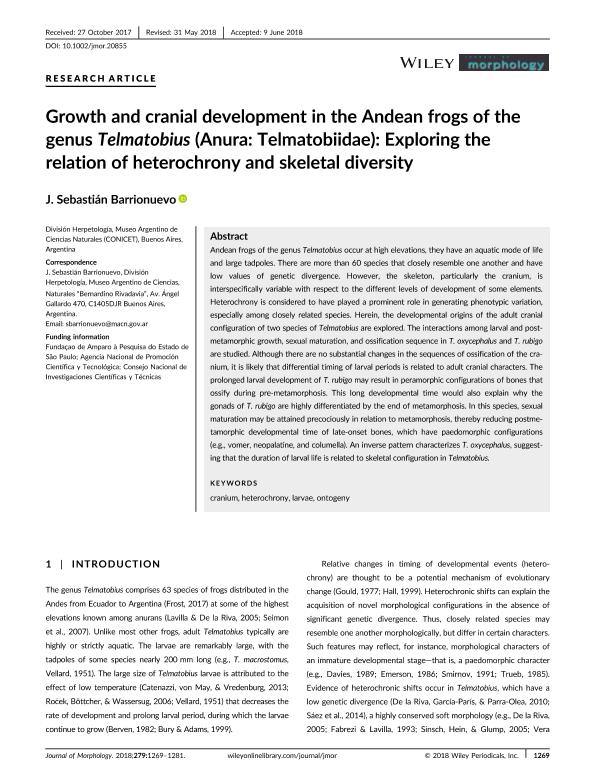Mostrar el registro sencillo del ítem
dc.contributor.author
Barrionuevo, Jose Sebastian

dc.date.available
2020-02-01T01:02:57Z
dc.date.issued
2018-09
dc.identifier.citation
Barrionuevo, Jose Sebastian; Growth and cranial development in the Andean frogs of the genus Telmatobius (Anura: Telmatobiidae): Exploring the relation of heterochrony and skeletal diversity; Wiley-liss, Div John Wiley & Sons Inc; Journal of Morphology; 279; 9; 9-2018; 1269-1281
dc.identifier.issn
0362-2525
dc.identifier.uri
http://hdl.handle.net/11336/96454
dc.description.abstract
Andean frogs of the genus Telmatobius occur at high elevations, they have an aquatic mode of life and large tadpoles. There are more than 60 species that closely resemble one another and have low values of genetic divergence. However, the skeleton, particularly the cranium, is interspecifically variable with respect to the different levels of development of some elements. Heterochrony is considered to have played a prominent role in generating phenotypic variation, especially among closely related species. Herein, the developmental origins of the adult cranial configuration of two species of Telmatobius are explored. The interactions among larval and postmetamorphic growth, sexual maturation, and ossification sequence in T. oxycephalus and T. rubigo are studied. Although there are no substantial changes in the sequences of ossification of the cranium, it is likely that differential timing of larval periods is related to adult cranial characters. The prolonged larval development of T. rubigo may result in peramorphic configurations of bones that ossify during pre-metamorphosis. This long developmental time would also explain why the gonads of T. rubigo are highly differentiated by the end of metamorphosis. In this species, sexual maturation may be attained precociously in relation to metamorphosis, thereby reducing postmetamorphic developmental time of late-onset bones, which have paedomorphic configurations (e.g., vomer, neopalatine, and columella). An inverse pattern characterizes T. oxycephalus, suggesting that the duration of larval life is related to skeletal configuration in Telmatobius.
dc.format
application/pdf
dc.language.iso
eng
dc.publisher
Wiley-liss, Div John Wiley & Sons Inc

dc.rights
info:eu-repo/semantics/openAccess
dc.rights.uri
https://creativecommons.org/licenses/by-nc-sa/2.5/ar/
dc.subject
CRANIUM
dc.subject
HETEROCHRONY
dc.subject
LARVAE
dc.subject
ONTOGENY
dc.subject.classification
Zoología, Ornitología, Entomología, Etología

dc.subject.classification
Ciencias Biológicas

dc.subject.classification
CIENCIAS NATURALES Y EXACTAS

dc.title
Growth and cranial development in the Andean frogs of the genus Telmatobius (Anura: Telmatobiidae): Exploring the relation of heterochrony and skeletal diversity
dc.type
info:eu-repo/semantics/article
dc.type
info:ar-repo/semantics/artículo
dc.type
info:eu-repo/semantics/publishedVersion
dc.date.updated
2020-01-31T18:58:13Z
dc.journal.volume
279
dc.journal.number
9
dc.journal.pagination
1269-1281
dc.journal.pais
Estados Unidos

dc.journal.ciudad
Nueva York
dc.description.fil
Fil: Barrionuevo, Jose Sebastian. Consejo Nacional de Investigaciones Científicas y Técnicas. Oficina de Coordinación Administrativa Parque Centenario. Museo Argentino de Ciencias Naturales “Bernardino Rivadavia”; Argentina
dc.journal.title
Journal of Morphology

dc.relation.alternativeid
info:eu-repo/semantics/altIdentifier/doi/http://dx.doi.org/10.1002/jmor.20855
dc.relation.alternativeid
info:eu-repo/semantics/altIdentifier/url/https://onlinelibrary.wiley.com/doi/abs/10.1002/jmor.20855
Archivos asociados
